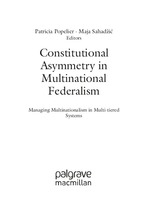| dc.contributor.author | Fessha, Yonatan | |
| dc.contributor.author | Bezabih, Biniyam | |
| dc.date.accessioned | 2020-08-14T15:28:29Z | |
| dc.date.available | 2020-08-14T15:28:29Z | |
| dc.date.issued | 2019 | |
| dc.identifier.citation | Fessha, Y. and Bezhabih, B. (2019) Federation among unequals. A country study of constitutional asymmetry in Ethiopia. In: Popelier, P. ed., Constitutional asymmetry in multinational federalism. Cham: Palgrave MacMillan | en_US |
| dc.identifier.isbn | 978-3-030-11700-9 | |
| dc.identifier.isbn | 978-3-030-11701-6 | |
| dc.identifier.uri | https://doi.org/10.1007/978-3-030-11701-6 | |
| dc.identifier.uri | http://hdl.handle.net/10566/5245 | |
| dc.description.abstract | Although some level of political asymmetry is unavoidable in any federal
arrangement, the problem of an Ethiopian federation affected by glaring
political asymmetry remains unexplored. The aim of this chapter is to
examine whether the political asymmetry that characterizes the federation
is translated into constitutional asymmetry and affects the working of the
federation. It seeks to unravel the repercussion of the unbalanced nature
of the existing ethnically defined states on the federation as a whole, ramifications
that, this chapter argues, have not fully come into effect because
of a ruling party that has effectively equalized the unequal subnational
entities. This, the paper concludes, is set to change as competitive politics
replaces the political space that is currently characterized by ‘one-party
dominance’, or even when the balance of power within the ruling party
goes under major reconfiguration, as seems to be happening these days.
The chapter commences the discussion by providing a historical
background of the federal system. It then moves to identify the political
asymmetrical features of the Ethiopian federal system. The chapter
further detects constitutional asymmetry and investigates the potential
and actual implications of the asymmetry for the functioning of the federation.
This is followed by a discussion that explores the link between
multinationalism and the asymmetry that characterizes the Ethiopian
federation. The chapter then explores whether the federal system has put
in place mechanisms that can help to moderate the effects of the asymmetry
before it concludes the discussion. | en_US |
| dc.language.iso | en | en_US |
| dc.publisher | Palgrave MacMillan | en_US |
| dc.relation.ispartofseries | Federalism and Internal Conflicts; | |
| dc.subject | Ethiopia | en_US |
| dc.subject | Federalism | en_US |
| dc.subject | Government | en_US |
| dc.subject | Constitution | en_US |
| dc.subject | Federal system | en_US |
| dc.title | Federation among unequals. A country study of constitutional asymmetry in Ethiopia | en_US |
| dc.type | Book chapter | en_US |

